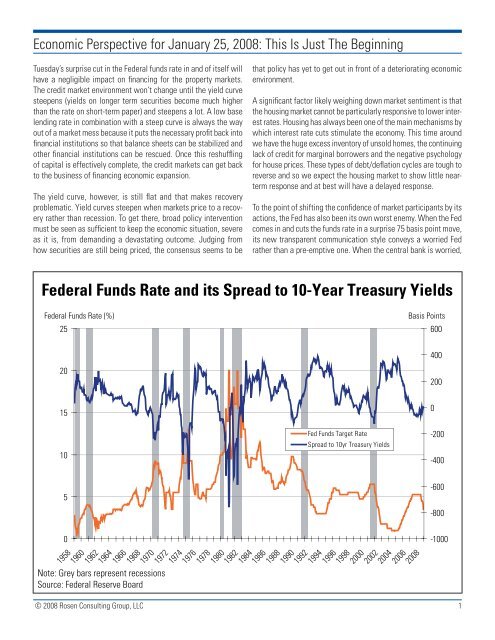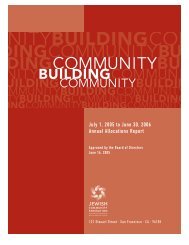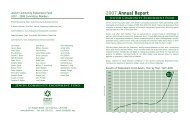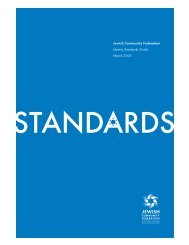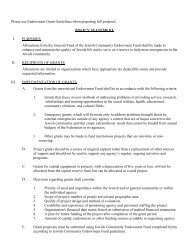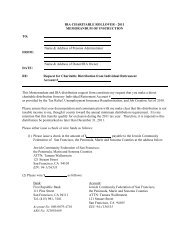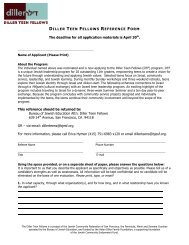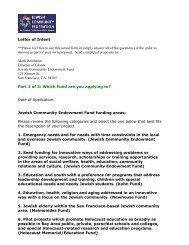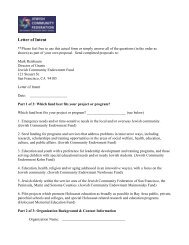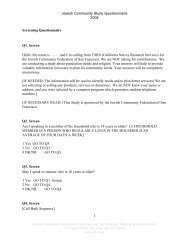Economic Perspective - Jewish Community Federation
Economic Perspective - Jewish Community Federation
Economic Perspective - Jewish Community Federation
Create successful ePaper yourself
Turn your PDF publications into a flip-book with our unique Google optimized e-Paper software.
<strong>Economic</strong> <strong>Perspective</strong> for January 25, 2008: This Is Just The Beginning<br />
Tuesday’s surprise cut in the Federal funds rate in and of itself will<br />
have a negligible impact on financing for the property markets.<br />
The credit market environment won’t change until the yield curve<br />
steepens (yields on longer term securities become much higher<br />
than the rate on short-term paper) and steepens a lot. A low base<br />
lending rate in combination with a steep curve is always the way<br />
out of a market mess because it puts the necessary profit back into<br />
fi nancial institutions so that balance sheets can be stabilized and<br />
other financial institutions can be rescued. Once this reshuffling<br />
of capital is effectively complete, the credit markets can get back<br />
to the business of fi nancing economic expansion.<br />
The yield curve, however, is still fl at and that makes recovery<br />
problematic. Yield curves steepen when markets price to a recovery<br />
rather than recession. To get there, broad policy intervention<br />
must be seen as sufficient to keep the economic situation, severe<br />
as it is, from demanding a devastating outcome. Judging from<br />
how securities are still being priced, the consensus seems to be<br />
that policy has yet to get out in front of a deteriorating economic<br />
environment.<br />
A significant factor likely weighing down market sentiment is that<br />
the housing market cannot be particularly responsive to lower interest<br />
rates. Housing has always been one of the main mechanisms by<br />
which interest rate cuts stimulate the economy. This time around<br />
we have the huge excess inventory of unsold homes, the continuing<br />
lack of credit for marginal borrowers and the negative psychology<br />
for house prices. These types of debt/deflation cycles are tough to<br />
reverse and so we expect the housing market to show little nearterm<br />
response and at best will have a delayed response.<br />
To the point of shifting the confidence of market participants by its<br />
actions, the Fed has also been its own worst enemy. When the Fed<br />
comes in and cuts the funds rate in a surprise 75 basis point move,<br />
its new transparent communication style conveys a worried Fed<br />
rather than a pre-emptive one. When the central bank is worried,<br />
Federal Funds Rate and its Spread to 10-Year Treasury Yields<br />
Federal Funds Rate (%)<br />
25<br />
Basis Points<br />
600<br />
400<br />
20<br />
200<br />
15<br />
0<br />
10<br />
5<br />
0<br />
1958<br />
1960<br />
1962<br />
Note: Grey bars represent recessions<br />
Source: Federal Reserve Board<br />
Fed Funds Target Rate<br />
Spread to 10yr Treasury Yields<br />
1964<br />
1966<br />
1968<br />
1970<br />
1972<br />
1974<br />
1976<br />
1978<br />
1980<br />
1982<br />
1984<br />
1986<br />
1988<br />
1990<br />
1992<br />
1994<br />
1996<br />
1998<br />
2000<br />
2002<br />
2004<br />
2006<br />
2008<br />
© 2008 Rosen Consulting Group, LLC 1<br />
-200<br />
-400<br />
-600<br />
-800<br />
-1000
markets are frightened. At some point the central bank needs to<br />
convey that its policy actions ensure a positive outcome rather<br />
than that they are chasing the market to stop the fall. The Federal<br />
funds rate will eventually be low enough to raise confidence in a<br />
recovery and thus steepen the curve. Therefore we believe that<br />
barring an unforeseen sudden shift in market sentiment, the funds<br />
rate isn’t low enough.<br />
How the low base lending rate/steep yield curve works to restart<br />
the flow of credit is by first creating the sharply wider net interest<br />
margins necessary to restore profit levels at financial institutions.<br />
Financial institutions are leveraged operations and so the low<br />
rate/steep curve sharply lowers the cost of carrying their inventory.<br />
As bank balance sheets stabilize, investors eventually grow weary<br />
of being “punished” for holding cash and then recommit capital to<br />
the credit markets in order to earn compensatory returns. A less<br />
stringent credit environment begins to unfold. This is the first sign of<br />
a turn towards growth—an environment obviously more conducive<br />
to real estate transactions.<br />
The central bank has engineered a positive curve for every recovery<br />
since 1958. This is illustrated in the accompanying chart<br />
that compares the Federal funds rate to the spread between the<br />
10-year Treasury yield and the target funds rate. Today’s flat yield<br />
curve is in no way close to what is necessary to move the economy<br />
toward recovery.<br />
Bringing the fi nancial system to heel is, however, much more<br />
problematic. Banks serve a unique function in the economy. They<br />
function freely to chase profits, like any firm in any industry, but we<br />
cannot afford to let them fail because the broader economy is then<br />
starved of the credit necessary to grow. Whether banks will still be<br />
given the free upside and socialized protection to the downside, a<br />
balance that only serves to increase the risk taking, is the debate<br />
that will take center stage once the current mess is behind us. In<br />
the meantime, the Federal Reserve is chartered to keep the banking<br />
system afloat and credit flowing to the economy at large, and that<br />
is exactly what they are doing.<br />
In sum, the required first steps have been taken but the flat curve<br />
says that the market has yet to begin discounting a recovery in its<br />
valuations. Until sentiment shifts to expectations for an upturn,<br />
the credit necessary to finance economic expansion will not be<br />
forthcoming. For the property markets, now so directly reliant on the<br />
capital markets to insure an inflow of credit, until a steeper curve<br />
stabilizes the debt markets, the credit crunch continues.<br />
—Steven Blitz<br />
A hallmark of the current expansion has been its unprecedented<br />
reliance on cheap credit created by an intricate and overly complex<br />
global financial system—a system that in and of itself was also<br />
a source of economic growth. The systemic risk inherent in the<br />
market’s unprecedented complexity means that low rates and a<br />
steep curve will likely need to be in place for an extended period<br />
in order to give the market the time necessary to unwind positions,<br />
bail out participants and get balance sheets back in order. There<br />
is some thought that the Fed needs to hold the line and allow the<br />
free market to punish the excess and thus bring to heel what has<br />
been an obviously out-of-control capital market—lest it risk a<br />
resumption of cheap credit and the attendant inflation risk. The<br />
dollar plays into this policy prescription as well, because the debt<br />
fueled U.S. economy is doomed to implosion if foreign investors<br />
demand signifi cantly higher real returns for their capital.<br />
© 2008 Rosen Consulting Group, LLC 2


